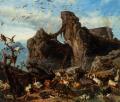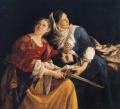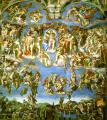| |
|
|
|
Bible scenes in art and paintingAnna Lea Merritt (1844-1930) Eve
Oil On Canvas -1885 76 x 109 cm ( 29,9 x 42,8 inch)
Private art collection
image: Public domain
Biblical scenes in painting have several characteristic features. Here are some of them: - 1. Depiction of important events: Painting Biblical scenes often depicts key episodes and events from the Bible, such as the birth of Jesus, crucifixion or Resurrection. These scenes represent significant moments in the history of Christianity.
- 2. Religious symbols: In the painting of Biblical scenes, symbolism is often used, which has religious and spiritual meanings. For example, angels, saints, temples and symbols of faith are often present in these works.
- 3. Reflection of emotions and drama: Picturesque Biblical scenes can convey a wide range of emotions, from joy and gratitude to sorrow and suffering. Artists strive to sincerely convey the depth of feelings and emotions associated with these events.
- 4. Visual Language and Style: Different artists can use different styles and techniques to depict Biblical scenes. Some approach it with a more classical or historical style, while others may resort to modern or expressionist approaches.
- 5. Attention to Detail and Composition: Artists depicting Biblical scenes usually pay great attention to the details of the visual narrative. They also strive to create harmonious compositions to emphasize the significance and meaning of the scene.
|
|
Pictures:
Samson and Delilah :: Alexandre Cabanel
 |
Judith Beheading Holofernes :: Caravaggio
 |
David Contemplating the Head of Goliath :: Orazio Gentleschi
 |
Judith :: Leon Francois Comerre
 |
After The Flood :: Filippo Palizzi
 |
The Lament of Jephthah's Daughter :: George Elgar Hicks
 |
Sacrifice of Manoah :: Pieter Lastman
 |
Esther before Ahasuerus :: Claude Vignon
 |
Eve :: Anna Lea Merritt
 |
The Finding of Moses [detail] :: Sir Lawrence Alma-Tadema
![The Finding of Moses [detail] :: Sir Lawrence Alma-Tadema Bible scenes in art and painting - The Finding of Moses [detail] :: Sir Lawrence Alma-Tadema](https://www.fineartlib.info/plugins/p17_image_gallery/images/tb/10/2918.jpg) |
Saint Mary Magdalen in Penitence :: Orazio Gentleschi
 |
Judith and Her Maidservant with the Head of Holofernes :: Orazio Gentleschi
 |
Eve Tempted :: George Frederick Watts
 |
Judith :: Benjamin Jean Joseph Constant
 |
David with the Head of Goliath :: Domenico Feti
 |
Moses before the Burning Bush :: Domenico Feti
 |
The Repentant St Mary Magdalene :: Domenico Feti
 |
The Last Judgement
 Title Italian: Il Giudizio universale Français : Le Jugement Dernier Date: 1541 Medium: fresco Dimensions: 1,370 × 1,220 cm (539.4 × 480.3 in) |
Holy Family :: AACHEN, Hans von
 |
Judith :: AACHEN Hans von
 aprox. 1600 |
|
Hide Comments (2)
|
|
|
Home-artlib >
|
|
|
|
|
|
|
|
|
The biblical theme is quite similar to the mythological one, that's why the artists portray heroes in the same idealizing way, trying to give to their pose and look the deepest meaning. They are monumental, mythical and canonical. Here everything is subject to strict rules and the authors usually adhere to the classical and traditional style.
1
Noli me tangere (1524)
The painting depicts the moment of the meeting of Christ with Mary Magdalene. Mary is a woman from Galilee in Christian legends, one of the myrrh-bearer. According to the gospel story, she was healed by Jesus Christ from the possession of seven demons. After that, she followed Christ, served him, sharing her wealth, attended Calvary at his death, and witnessed his burial. After the Sabbath had passed a ban on the case and movement, she with the other myrrh-bearers [Expand]
2